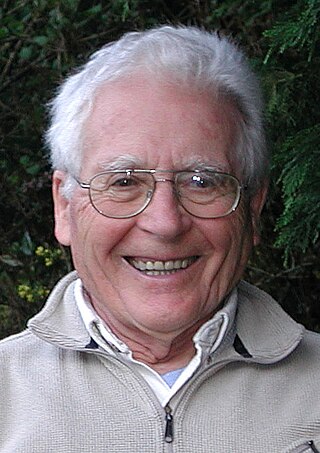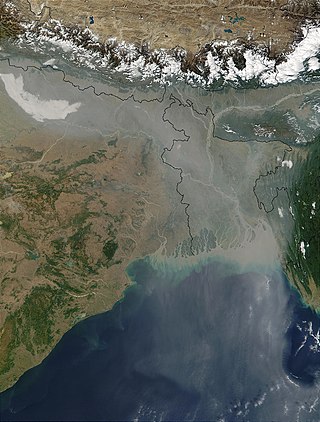Related Research Articles

James Ephraim Lovelock was an English independent scientist, environmentalist and futurist. He is best known for proposing the Gaia hypothesis, which postulates that the Earth functions as a self-regulating system.

Phytoplankton are the autotrophic (self-feeding) components of the plankton community and a key part of ocean and freshwater ecosystems. The name comes from the Greek words φυτόν, meaning 'plant', and πλαγκτός, meaning 'wanderer' or 'drifter'.

Chlorofluorocarbons (CFCs) and hydrochlorofluorocarbons (HCFCs) are fully or partly halogenated hydrocarbons that contain carbon (C), hydrogen (H), chlorine (Cl), and fluorine (F), produced as volatile derivatives of methane, ethane, and propane.

SimEarth: The Living Planet is a life simulation game, the second designed by Will Wright. and published in 1990 by Maxis. In SimEarth, the player controls the development of a planet. English scientist James Lovelock served as an advisor and his Gaia hypothesis of planet evolution was incorporated into the game. Versions were made for the Macintosh, Atari ST, Amiga, IBM PC, Super Nintendo Entertainment System, Sega CD, and TurboGrafx-16. It was re-released for the Wii Virtual Console. In 1996, several of Maxis' simulation games were re-released under the Maxis Collector Series with greater compatibility with Windows 95 and differing box art, including the addition of Classics beneath the title. SimEarth was re-released in 1997 under the Classics label.

Daisyworld, a computer simulation, is a hypothetical world orbiting a star whose radiant energy is slowly increasing or decreasing. It is meant to mimic important elements of the Earth-Sun system. James Lovelock and Andrew Watson introduced it in a paper published in 1983 to illustrate the plausibility of the Gaia hypothesis. In the original 1983 version, Daisyworld is seeded with two varieties of daisy as its only life forms: black daisies and white daisies. White petaled daisies reflect light, while black petaled daisies absorb light. The simulation tracks the two daisy populations and the surface temperature of Daisyworld as the sun's rays grow more powerful. The surface temperature of Daisyworld remains almost constant over a broad range of solar output.

The Gaia hypothesis, also known as the Gaia theory, Gaia paradigm, or the Gaia principle, proposes that living organisms interact with their inorganic surroundings on Earth to form a synergistic and self-regulating, complex system that helps to maintain and perpetuate the conditions for life on the planet.

Sulfur hexafluoride or sulphur hexafluoride (British spelling) is an inorganic compound with the formula SF6. It is a colorless, odorless, non-flammable, and non-toxic gas. SF
6 has an octahedral geometry, consisting of six fluorine atoms attached to a central sulfur atom. It is a hypervalent molecule.

Cloud condensation nuclei (CCNs), also known as cloud seeds, are small particles typically 0.2 μm, or one hundredth the size of a cloud droplet. CCNs are a unique subset of aerosols in the atmosphere on which water vapour condenses. This can affect the radiative properties of clouds and the overall atmosphere. Water vapour requires a non-gaseous surface to make the transition to a liquid; this process is called condensation.

Tyler Volk is Professor Emeritus of Environmental Studies and Biology at New York University.

The Great Oxidation Event (GOE) or Great Oxygenation Event, also called the Oxygen Catastrophe, Oxygen Revolution, Oxygen Crisis or Oxygen Holocaust, was a time interval during the Earth's Paleoproterozoic era when the Earth's atmosphere and shallow seas first experienced a rise in the concentration of free oxygen. This began approximately 2.460–2.426 Ga (billion years) ago during the Siderian period and ended approximately 2.060 Ga ago during the Rhyacian. Geological, isotopic and chemical evidence suggests that biologically produced molecular oxygen (dioxygen or O2) started to accumulate in the Archean prebiotic atmosphere due to microbial photosynthesis, and eventually changed it from a weakly reducing atmosphere practically devoid of oxygen into an oxidizing one containing abundant free oxygen, with oxygen levels being as high as 10% of modern atmospheric level by the end of the GOE.
The Alexander Agassiz Medal is awarded every three years by the U.S. National Academy of Sciences for an original contribution in the science of oceanography. It was established in 1911 by Sir John Murray in honor of his friend, the scientist Alexander Agassiz.

Iron fertilization is the intentional introduction of iron-containing compounds to iron-poor areas of the ocean surface to stimulate phytoplankton production. This is intended to enhance biological productivity and/or accelerate carbon dioxide sequestration from the atmosphere. Iron is a trace element necessary for photosynthesis in plants. It is highly insoluble in sea water and in a variety of locations is the limiting nutrient for phytoplankton growth. Large algal blooms can be created by supplying iron to iron-deficient ocean waters. These blooms can nourish other organisms.

Ocean fertilization or ocean nourishment is a type of technology for carbon dioxide removal from the ocean based on the purposeful introduction of plant nutrients to the upper ocean to increase marine food production and to remove carbon dioxide from the atmosphere. Ocean nutrient fertilization, for example iron fertilization, could stimulate photosynthesis in phytoplankton. The phytoplankton would convert the ocean's dissolved carbon dioxide into carbohydrate, some of which would sink into the deeper ocean before oxidizing. More than a dozen open-sea experiments confirmed that adding iron to the ocean increases photosynthesis in phytoplankton by up to 30 times.

The CLAW hypothesis proposes a negative feedback loop that operates between ocean ecosystems and the Earth's climate. The hypothesis specifically proposes that particular phytoplankton that produce dimethyl sulfide are responsive to variations in climate forcing, and that these responses act to stabilise the temperature of the Earth's atmosphere. The CLAW hypothesis was originally proposed by Robert Jay Charlson, James Lovelock, Meinrat Andreae and Stephen G. Warren, and takes its acronym from the first letter of their surnames.
Timothy Michael LentonFGS FLS FRSB is Professor of Climate Change and Earth System Science at the University of Exeter. In April 2013 he was awarded the Royal Society Wolfson Research Merit Award.
Organic molecular tracers in pollution control and environmental science are referred to as organic molecular markers or emission markers, and are compounds or compound classes. These tracers are of interest in the field of air quality because they can help identify particulate emission sources, as they are relatively unique to those sources. This approach is generally applied to particulate matter under 2.5μm in diameter because of the formation mechanisms and the health risks associated with this size regime. With tracer compounds, the principles of mass balance are used to 'trace' emissions from the source to the receptor site where a sample is taken. Use of organic tracers has become more common as measurement quality has improved, costs have decreased, and compounds that were historically good tracers, such as lead, have decreased in ambient concentrations due to various factors including government regulation.
Fluorinated gases (F-gases) are a group of gases containing fluorine. They are divided into several types, the main of those are hydrofluorocarbons (HFCs), perfluorocarbons (PFCs), sulphur hexafluoride (SF6). They are used in refrigeration, air conditioning, heat pumps, fire suppression, electronics, aerospace, magnesium industry, foam and high voltage switchgear. As they are greenhouse gases with a strong global warming potential, their use is regulated.
Julie LaRoche is a Canadian marine biologist. She is a Tier 1 Canada Research Chair in Marine Microbial Genomics and Biogeochemistry at Dalhousie University.
Glenn Edmond Shaw is an American scientist specializing in atmospheric physics, especially relating to global climate change and long-range transport of aerosol material. He is Emeritus Professor of Physics and Atmospheric Science at the University of Alaska Fairbanks and a member of the scientific staff of the Geophysical Institute. He conducted research on global atmospheric transport of aerosols and feedback of biogenic aerosols on global climate. He and Kenneth Rahn did research on the sources and climatic effect of Arctic haze. He did pioneering work on the scientific concept of climate homeostasis through the sulfur cycle and atmospheric aerosol.
The Neoproterozoic Oxygenation Event (NOE), also called the Second Great Oxidation Event, was a time interval between around 850 and 540 million years ago which saw a very significant increase in oxygen levels in Earth's atmosphere and oceans. Bringing an end to the Boring Billion, a period of extremely low atmospheric oxygen spanning from the Statherian to the Tonian, the NOE was the second major increase in atmospheric and oceanic oxygen concentration on Earth, though it was not as large as the Great Oxidation Event (GOE) of the Neoarchean-Paleoproterozoic boundary. Unlike the GOE, it is unclear whether the NOE was a synchronous, global event or a series of asynchronous, regional oxygenation intervals with unrelated causes.
References
- ↑ "Professor Tim Lenton Chair in Climate Change/Earth Systems Science". University of Exeter. Retrieved 22 July 2012.
- ↑ Watson, A. J. and J. E. Lovelock (1983). Biological homeostasis of the global environment: the parable of Daisyworld. Tellus 35B, 284-289
- ↑ Watson, A. J., (2004). Gaia and observer self-selection. In Scientists debate Gaia: the next century, eds Schneider, S. H., Miller, J. R., Crist, E., and Boston, P. J. pp201-208. MIT press, Cambridge, Mass, USA.
- ↑ Watson, A. J., Liddicoat, M. I. and J. R. Ledwell (1987). "Perfluorodecalin and sulphur hexafluoride as purposeful marine tracers: some deployment and analysis techniques." Deep-Sea Research, 34, 19-31.
- ↑ Ledwell, J. R., Watson, A. J., and Law, C. S. (1993). Evidence of slow mixing across the pycnocline from an open ocean tracer release experiment. Nature. 364, 701-703
- ↑ Watson, A. J., Upstill-Goddard R. C. and P. S. Liss (1991). Air- sea gas exchange in rough and stormy seas measured by a dual- tracer technique. Nature 349, 145-147.
- ↑ Watson, A. J., P. S. Liss, and R. A. Duce (1992). Design of a small-scale iron fertilisation experiment. Limnology and Oceanography 36, 1960-1965
- ↑ . Boyd, P. W., et al., (2007). Mesoscale iron-enrichment experiments 1993-2005: synthesis and future directions. Science 315, 612-61
- ↑ Lenton, Tim; Watson, Andrew (20 January 2011). Revolutions that Made the Earth. ISBN 978-0199587049.
- ↑ "Watson interviewd by Cunk". BBC2. 19 February 2015 – via YouTube.
